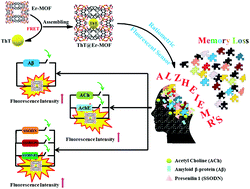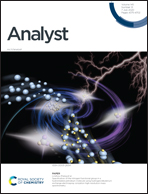Driving force to detect Alzheimer's disease biomarkers: application of a thioflavine T@Er-MOF ratiometric fluorescent sensor for smart detection of presenilin 1, amyloid β-protein and acetylcholine†
Abstract
Currently, the highly sensitive detection of Alzheimer's Disease (AD) biomarkers, namely presenilin 1, amyloid β-protein (Aβ), and acetylcholine (ACh), is vital to helping us prevent and diagnose AD. In this work, a novel metal–organic framework [Er(L)(DMF)1.27]n (Er-MOF) (H3L = terphenyl-3,4′′,5-tricarboxylic acid) has been synthesized by solvothermal and ultrasonic methods. Further, through the post-synthesis assembly strategy, the fluorescent dye thioflavine T (ThT) has been introduced into Er-MOF to construct a dual-emission ThT@Er-MOF ratiometric fluorescent sensor. This is the first time that ThT@Er-MOF has been successfully applied in the highly sensitive detection of three main Alzheimer's disease biomarkers in the cerebrospinal fluid through three different low cost and facile detection strategies. Firstly, with the spilted DNA strategy, this is the first time that ThT@Er-MOF can be applied in the label-free detection of SSODN (part of the presenilin 1 gene). Secondly, for the detection of Aβ, because ThT can be specifically combined with Aβ and has an excellent characteristic fluorescence band, the dual-emission ThT@Er-MOF sensor can be selectively applied to detect Aβ over the analog protein, which shows far more sensitivity than other Aβ sensors. Thirdly, through the acetylcholine esterase (AchE) enzymatic cleavage and release strategy, ThT@Er-MOF enhances the detection of acetylcholine (ACh) with a low limit of detection (LOD) value (0.03226 nM). It should be noticed that the three different detection methods are low cost and facile. This study also provides the first example of utilizing laser scanning confocal microscopy (LSCM) to investigate the fluorescence resonance energy transfer (FRET) detection mechanism by ThT@Er-MOF in more detail. The location of FRET occurrence and FRET efficiency can also be investigated by LSCM, which can be helpful to understand the FRET detection process by these unique MOF-based hybrid materials.



 Please wait while we load your content...
Please wait while we load your content...